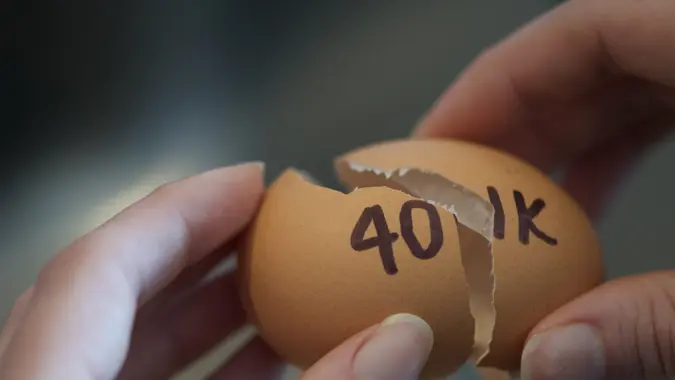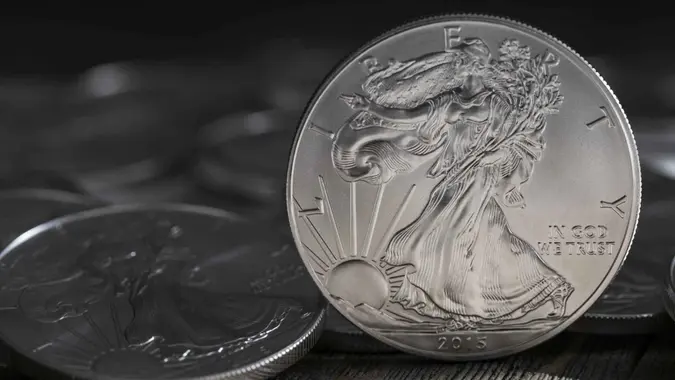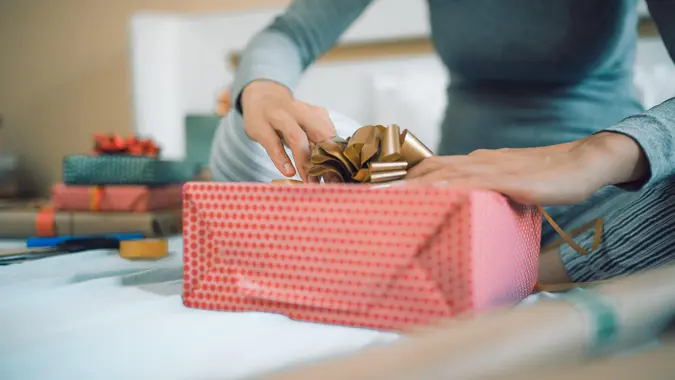4 Poor Money Habits Many Women Are Guilty Of — And How To Break Them

Commitment to Our Readers
GOBankingRates' editorial team is committed to bringing you unbiased reviews and information. We use data-driven methodologies to evaluate financial products and services - our reviews and ratings are not influenced by advertisers. You can read more about our editorial guidelines and our products and services review methodology.

20 Years
Helping You Live Richer

Reviewed
by Experts

Trusted by
Millions of Readers
If you’re struggling with poor money habits, being able to acknowledge your financial mistakes now is the first step to creating a healthier financial future. And you’re not alone. According to GOBankingRates’ “Women and Finance Survey 2024,” when women were asked to choose their worst money habit, these were the results:
- Impulse shopping — 21%
- Not having or sticking to a budget — 18%
- Only paying the minimum balance on credit card bills — 15%
- Ordering food delivery too often — 8%
Making financial mistakes isn’t something to get down in the dumps about, though. Instead, look at your struggles as an opportunity to make a change. Here’s more about the poor money habits many women are guilty of — and how you can start turning things around today.
Bad Habit No. 1: Impulse Shopping
“As women, we are more likely to engage in impulsive behavior,” said Alejandra Rojas, a trauma-informed finance professional, founder of The Money Mindset Hub and host of “The Money Mindset Show Podcast.” “This is largely driven by a combination of emotional brain takeover (over the logical), a lack of financial tools to prevent it and the fact that a lot of advertising is targeted at that emotional reaction.”
How To Break It
Rojas said that to break an impulsive spending habit you should combine the following strategies:
- “Set up strategies that help you engage the logical brain when emotions take over,” she suggested. “For instance, leave your cards at home unless it’s planned to use them, set limits on your cards and take a break before a purchase to reassess its necessity.
- “Address the emotional root of the impulse. The purchase itself is just a symptom, not the cause. It’s important to understand what triggers the behavior, which often relates to financial trauma.”
Bad Habit No. 2: Not Having or Sticking to a Budget
According to Rojas, failing to either have or stick to a budget can often be attributed to a lack of financial literacy and understanding of how a money plan fits into one’s daily life.
“Budgeting is often seen as a ‘must-do’ but pointless task, which makes it hard to stick to,” she explained. “My best advice is to fundamentally change the view of budgeting. Treat it like a plan you look forward to — similar to planning a holiday or a day off.”
How To Break It
To break this bad habit, Rojas said you need to create enough interest so that money planning becomes easier to you and “sticks.”
“In my case, I use multi-level communication that speaks to both the logical and subconscious minds (where interest and engagement are built),” she explained. “Set realistic, achievable goals to create a ripple effect. It’s best to start money planning, or budgeting, for specific goals and achieve them first, regardless of size, so that you start shifting the perspective.”
Bad Habit No. 3: Only Paying the Minimum on Credit Card Bills
“Paying the minimum amounts on credit cards often reflects a lack of financial literacy and an understanding of what the minimum payment represents, alongside the financial trauma of mismanaged debt,” Rojas explained.
How To Break It
Rojas recommends following these steps to break your minimum payment habit:
- Go on a credit card detox for two weeks to understand your current usage.
- Get curious about how much progress the minimum payment provides and how it impacts your credit life.
- Create a money plan that considers fully paying down debt and provides a clear roadmap.
- Lean on professional help that understands your situation and can guide you in creating effective credit use strategies.
Bad Habit No. 4: Ordering Food Delivery Too Often
Rojas said that making frequent food delivery orders is most likely driven by the fast pace of modern lifestyles. “However, similar to impulsive behavior, it’s the result, not the cause,” she said.
How To Break It
“To break the habit of ordering takeout, you need to have a reward on the other side to make it stick — make it fun not to order food. For instance, why not have a dinner date with friends to meal prep? You’d be more likely to think twice before ordering.”
Rojas also suggested having a well-stocked fridge, if possible, and creating a cozy environment at home that works well for your social life — both of which will help you break your food-ordering habit.
“Ultimately, this is more about the psychology of spending. Become curious about what makes you enjoy eating at home and do more of that, while identifying what makes you dislike ordering delivery.”
 Written by
Written by  Edited by
Edited by 

























